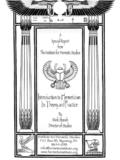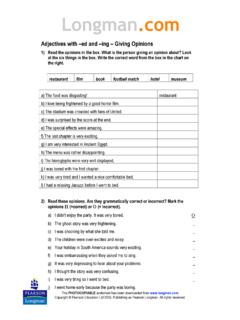Transcription of Cricket Scoring - The basics - 12 Stars Cricket Club
1 Incorporating the MCC Laws of Cricket 2000 code - 4th edition 2010 Cricket Scoring The basics - The Cricket scorer s art can be as complicated or as simple as you care to make it. It is not simple, but it s not rocket science either. It requires concentration, a bit of help from a team mate who can confirm an umpire s signal or the number of runs completed, and it requires a proper understanding of the hieroglyphs that are the Cricket Scoring symbols . So here goes: Inexperienced scorers often get the NO-BALL and WIDE-ball symbols mixed up but remembering which is which is quite easy if you liken the WIDE-ball symbol to the umpires stance - standing arms out to the side in the shape of a cross. However, it gets a little more complicated when combinations of Scoring issues are added to the mix: The circle symbol as above indicates NO-BALL. But, if the batsman hits the ball and scores a run or runs, or a Boundary 4 or a Boundary 6 off a delivery, then the runs are marked inside the circle.
2 In practice, it is easier to write down the number then encircle it rather than try to put the numeral inside the circle. These are batsman s runs and the NO-BALL itself is a NO-BALL extra. Often you might see a NO-BALL delivery elude the wicket-keeper and the batsmen complete one or more runs, when the ball becomes dead, the umpire will signal NO-BALL, and when you have acknowledged that signal he may also signal Boundary 4. In this case, the Bye is recorded with 1 or more dots. Again, it is easier to encircle the dots rather than put dots into a circle. All runs completed, or the Boundary 4, are recorded as NO-BALL extras. With WIDE deliveries, it is common to see batsmen run complete one or more runs, or the ball may reach the boundary. Here the umpire will signal WIDE-ball, then when you have acknowledged that signal, he will signal Boundary 4. All of these runs are recorded as WIDE extras.
3 The only other possible addition to the WIDE symbol is if the batsman hits the stumps with his bat or person or the wicket-keeper stumps him. The batsman would be out and a W is added to the WIDE cross symbol. The WIDE is a WIDE extra and the bowler is credited with the wicket. NO-BALLS & WIDE-balls are Bowling extras these are runs gifted to the batting side and are debited against the bowler. Byes & Leg-byes are Fielding extras these are runs gifted to the batting side and are debited against the fielding side. Now we know which symbols to use and what they mean, how do we interpret them in the Batting, Bowling, Extras and the Totals analysis? The most common form of Scoring uses the Box method; named after the designer Charles Box in 1877, not after the style. Here using that method, we develop that showing a ball-by-ball account: Let us look at a bowler s analysis for 3 overs shown to the left above.
4 In the first over the bowler bowled a dot ball, then a NO-BALL which the batsmen hit and scored 3 runs, another dot ball, then a WIDE-ball which the batsmen ran 2, another dot ball, the batsman scored 1 run off the next, 4 runs off the following delivery and the final delivery of the over was another dot ball. That is 8 deliveries (balls) in that over. 6 fair deliveries, plus an extra delivery for the NO-BALL, and an extra delivery for the WIDE-ball. In the over summary at the bottom of that box, we record 12-0; that s 12 runs for 0 wickets; 1 for the NO-BALL plus 3 the batsmen ran, 1 for the WIDE-ball plus the 2 Byes, 1 run and 4 runs; Total 12 runs. In the batsman s analysis, whether we record ball-by-ball, he would be credited with 8 runs off that over (more on this later). In the EXTRAS analysis, above right, we add a total of 4. 1 NO-BALL extra and 3 WIDE-ball extras and in the total runs Tally we should have 12 as our total.
5 For the next over we record 2 runs, dot, dot, WIDE-ball, dot, 1 run, Bye (as these do not count against or for the bowler we do not record how many). The bowling totals for this over would be 4 runs, which gives a cumulative total of 16 for 0 wickets. The batsmen have added 3, Byes (let us call it 1 in this example) have been added to the EXTRAS analysis and 1 has been added to the WIDE extras. The total runs Tally stands at 17. In the third over we have a Leg-bye (as these do not count against or for the bowler we do not record how many but we ll call it 2 in this example) a wicket, a dot ball, a NO-BALL with 2 Byes, 3 runs, dot and 1 run. The bowler s cumulative total stands at 23 for 1. The batsmen have a total of 15 and there are now a total of 11 EXTRAS (8 bowling and 3 fielding as example above). The total runs Tally stands at 26. How do we check that this is correct?
6 Simply remember that: 1. The total of ALL batsman s scores PLUS ALL extras = THE TOTAL SCORE 2. The total of ALL bowler s totals PLUS all FIELDING extras = THE TOTAL SCORE 3. The total of ALL batsman s scores PLUS all BOWLING extras = THE BOWLING TOTALS Do the math yourself and you will see how the examples above work out exactly. At the end of each over the Scoring rate column is completed, above. (Unfortunately this is not always provided in many score-books). Here we record the cumulative total runs at the end of that over, which is the total runs Tally. The difference between this and the total at the end of the previous over gives you the runs scored in the over. We also record the cumulative number of wickets that have fallen at the end of that over, and finally we record which bowler bowled the over. If you look at the example above you see that this also provides a snapshot of how things stand in a match.
7 In this case, 20 runs for the loss of 2 wickets at the end of the 5th over. At club level, they may have 1 or 2 dedicated scorers, who are able to record all the niceties such as the bowler s action, the number of deliveries a batsman faces, duration of partnerships etc. At lower levels this is difficult often because the scorer is a player and they are recording figures in those stupid little score-books that require the handwriting size of the tooth fairy, when what s really needed is an A3 size score-sheet at least, and all the while they are waiting for a break so they can pad up. Bowling figures can cause problems generally because the player doing the Scoring has never had it explained properly and has just picked it up from a team mate who learned it exactly the same way. Because of the limitations of space, we generally only record the batsman s runs in the batting analysis, which is a shame because most players would like some idea of the number of balls faced and their strike rate.
8 Properly done, a batsman s analysis will mirror the bowler s over the course of an over. So we would record every dot ball, NO-BALL, WIDE-ball, Scoring shots, Bye and Leg-bye ball delivered in their figures; batsmen of-course are only credited with runs off their bat. This provides us with a total of balls faced over the course of their innings. Note: When totting up these figures, remember not to include WIDE deliveries as balls faced by a batsman; they are recorded as balls bowled of-course, but because they were too wide for the batsman to hit it, they should not be recorded as balls faced. At competition level you need to understand and record other details but I m sure you ll find this enough to be getting on with. If you would like to learn more about Scoring , the booklet Cricket Scoring Getting started is on the NZC website. 2010 NZC-NZCUSA







